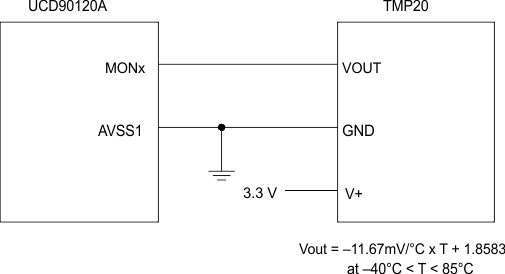ZHCS212C April 2011 – March 2019 UCD90120A
PRODUCTION DATA.
- 1 特性
- 2 应用
- 3 说明
- 4 修订历史记录
- 5 Pin Configuration and Functions
- 6 Specifications
-
7 Detailed Description
- 7.1 Overview
- 7.2 Functional Block Diagram
- 7.3 Feature Description
- 7.4
Device Functional Modes
- 7.4.1 Power-Supply Sequencing
- 7.4.2 Pin-Selected Rail States
- 7.4.3 Monitoring
- 7.4.4 Fault Responses and Alert Processing
- 7.4.5 Shut Down All Rails and Sequence On (Resequence)
- 7.4.6 GPIOs
- 7.4.7 GPO Control
- 7.4.8 GPO Dependencies
- 7.4.9 GPO Delays
- 7.4.10 State Machine Mode Enable
- 7.4.11 GPI Special Functions
- 7.4.12 Power-Supply Enables
- 7.4.13 Cascading Multiple Devices
- 7.4.14 PWM Outputs
- 7.4.15 Programmable Multiphase PWMs
- 7.4.16 Margining
- 7.4.17 System Reset Signal
- 7.4.18 Watch Dog Timer
- 7.4.19 Run Time Clock
- 7.4.20 Data and Error Logging to Flash Memory
- 7.4.21 Brownout Function
- 7.4.22 PMBus Address Selection
- 7.5 Programming
- 8 Application and Implementation
- 9 Power Supply Recommendations
- 10Layout
- 11器件和文档支持
- 12机械、封装和可订购信息
7.4.3.3 Remote Temperature Monitoring and Internal Temperature Sensor
The UCD90120A has support for internal and remote temperature sensing. The internal temperature sensor requires no calibration and can report the device temperature via the PMBus interface. The remote temperature sensor can report the remote temperature by using a configurable gain and offset for the type of sensor that is used in the application such as a linear temperature sensor (LTS) connected to the analog inputs.
External circuitry must be used in order to convert the temperature to a voltage within the range of the UCD90120A MONx input being used.
If an input is configured as a temperature, the measurements are smoothed by a sliding average digital filter. The temperature for 1 rail is measured every 100ms. If the device is programmed to support 10 rails (independent of temperature not being monitored at all rails), then each rail's temperature will get measured every 1s. The temperature calculation is done with a sliding average using the last 16 measurements. The filter reduces the probability of false fault detections, and introduces a small delay to the temperature reading. The internal device temperature is measured using a silicon diode sensor with an accuracy of ±5°C and is also monitored using the ADC. Temperature monitoring begins immediately after reset and initialization.
The device supports multiple PMBus commands related to temperature, including READ_TEMPERATURE_1, which reads the internal temperature; READ_TEMPERATURE_2, which reads external temperatures; and OT_FAULT_LIMIT and OT_WARN_LIMIT, which set the overtemperature fault and warning limit. The UCD90xxx Sequencer and System Health Controller PMBus Command Reference contains a detailed description of how temperature-fault responses are implemented using PMBus commands.
TEMPERATURE_CAL_GAIN is a PMBus command that allows the scale factor of an external temperature sensor and any amplifiers or attenuators between the temperature sensor and the MON pin to be entered by the user in °C/V. TEMPERATURE_CAL_OFFSET is the temperature that results in 0 V at the MON pin. The combination of these PMBus commands allows temperature to be reported in degrees Celsius.
 Figure 14. Remote Temperature Monitoring Circuit Example Using the TMP20
Figure 14. Remote Temperature Monitoring Circuit Example Using the TMP20